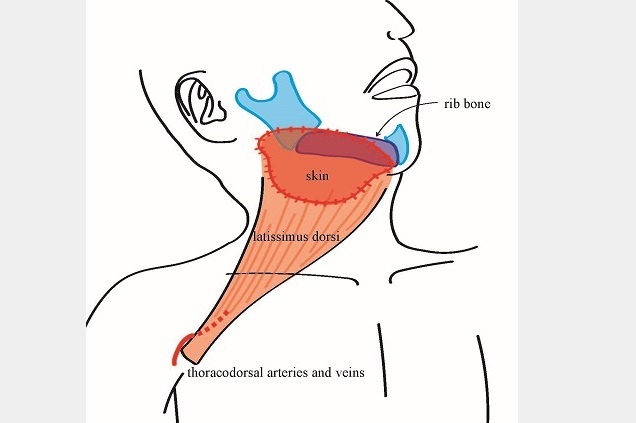New Technique Safer and Faster for Cancer Patients Undergoing Head and Neck Reconstruction
|
By HospiMedica International staff writers Posted on 13 Dec 2024 |

Head and neck reconstruction is essential in the treatment of patients with head and neck cancer, aiming to preserve vital functions such as breathing, eating, and speaking, while also maintaining appearance and quality of life. Researchers have now introduced an innovative technique for head and neck reconstruction that shifts the positioning of transferred tissue with attached blood vessels, offering a safer and faster alternative for patients with complex tissue defects, particularly those at high risk.
Traditional reconstruction methods often involve free flaps, which may not be suitable for certain patients, such as those who have undergone prior radiation treatment or multiple surgeries. A free flap involves detaching a section of tissue from a healthy donor site and reattaching it to new blood vessels at the recipient site. However, the research team at Osaka Metropolitan University (Osaka, Japan) took a different approach by using pedicled latissimus dorsi (LD) myocutaneous flaps, which remain partially attached to the donor site, preserving their natural blood supply as they are relocated to the recipient site for reconstruction.
While the LD flap has been used in various reconstructive procedures, the team developed a novel technique by positioning the skin portion of the LD flap more distally on the back, compared to traditional methods. This design incorporates the lateral cutaneous branch of the 10th posterior intercostal artery, ensuring a reliable blood flow to the flap. The study, which was conducted from 2003 to 2024, showed that the pedicled LD flap was successfully integrated in all 22 patients with complex head and neck defects. The results of the study were published in the journal Plastic and Reconstructive Surgery—Global Open.
“Traditional reconstruction typically uses free flaps, which may not be feasible for some patients, such as those who have had prior radiation treatment or multiple surgeries,” said Tsubasa Kojima, a medical doctor and lecturer at Osaka Metropolitan University’s Graduate School of Medicine and lead author of the study. “This setup provides flexibility, allowing the LD flap to cover extensive defects, including those in both the mouth and neck simultaneously, and even facilitates jaw reconstruction by incorporating rib bone.”
Latest Surgical Techniques News
- Early TAVR Intervention Reduces Cardiovascular Events in Asymptomatic Aortic Stenosis Patients
- New Procedure Found Safe and Effective for Patients Undergoing Transcatheter Mitral Valve Replacement
- No-Touch Vein Harvesting Reduces Graft Failure Risk for Heart Bypass Patients
- DNA Origami Improves Imaging of Dense Pancreatic Tissue for Cancer Detection and Treatment
- Pioneering Sutureless Coronary Bypass Technology to Eliminate Open-Chest Procedures
- Intravascular Imaging for Guiding Stent Implantation Ensures Safer Stenting Procedures
- World's First AI Surgical Guidance Platform Allows Surgeons to Measure Success in Real-Time
- AI-Generated Synthetic Scarred Hearts Aid Atrial Fibrillation Treatment
- New Class of Bioadhesives to Connect Human Tissues to Long-Term Medical Implants
- New Transcatheter Valve Found Safe and Effective for Treating Aortic Regurgitation
- Minimally Invasive Valve Repair Reduces Hospitalizations in Severe Tricuspid Regurgitation Patients
- Tiny Robotic Tools Powered by Magnetic Fields to Enable Minimally Invasive Brain Surgery
- Magnetic Tweezers Make Robotic Surgery Safer and More Precise
- AI-Powered Surgical Planning Tool Improves Pre-Op Planning
- Novel Sensing System Restores Missing Sense of Touch in Minimally Invasive Surgery
- Headset-Based AR Navigation System Improves EVD Placement
Channels
Critical Care
view channel
AI Interpretability Tool for Photographed ECG Images Offers Pixel-Level Precision
The electrocardiogram (ECG) is a crucial diagnostic tool in modern medicine, used to detect heart conditions such as arrhythmias and structural abnormalities. Every year, millions of ECGs are performed... Read more
AI-ECG Tools Can Identify Heart Muscle Weakness in Women Before Pregnancy
Each year, some mothers die from heart-related issues after childbirth, with many of these deaths being preventable. Screening for heart weakness before pregnancy could be crucial in identifying women... Read morePatient Care
view channel
Portable Biosensor Platform to Reduce Hospital-Acquired Infections
Approximately 4 million patients in the European Union acquire healthcare-associated infections (HAIs) or nosocomial infections each year, with around 37,000 deaths directly resulting from these infections,... Read moreFirst-Of-Its-Kind Portable Germicidal Light Technology Disinfects High-Touch Clinical Surfaces in Seconds
Reducing healthcare-acquired infections (HAIs) remains a pressing issue within global healthcare systems. In the United States alone, 1.7 million patients contract HAIs annually, leading to approximately... Read more
Surgical Capacity Optimization Solution Helps Hospitals Boost OR Utilization
An innovative solution has the capability to transform surgical capacity utilization by targeting the root cause of surgical block time inefficiencies. Fujitsu Limited’s (Tokyo, Japan) Surgical Capacity... Read more
Game-Changing Innovation in Surgical Instrument Sterilization Significantly Improves OR Throughput
A groundbreaking innovation enables hospitals to significantly improve instrument processing time and throughput in operating rooms (ORs) and sterile processing departments. Turbett Surgical, Inc.... Read moreHealth IT
view channel
Printable Molecule-Selective Nanoparticles Enable Mass Production of Wearable Biosensors
The future of medicine is likely to focus on the personalization of healthcare—understanding exactly what an individual requires and delivering the appropriate combination of nutrients, metabolites, and... Read more
Smartwatches Could Detect Congestive Heart Failure
Diagnosing congestive heart failure (CHF) typically requires expensive and time-consuming imaging techniques like echocardiography, also known as cardiac ultrasound. Previously, detecting CHF by analyzing... Read moreBusiness
view channel
Expanded Collaboration to Transform OR Technology Through AI and Automation
The expansion of an existing collaboration between three leading companies aims to develop artificial intelligence (AI)-driven solutions for smart operating rooms with sophisticated monitoring and automation.... Read more

















